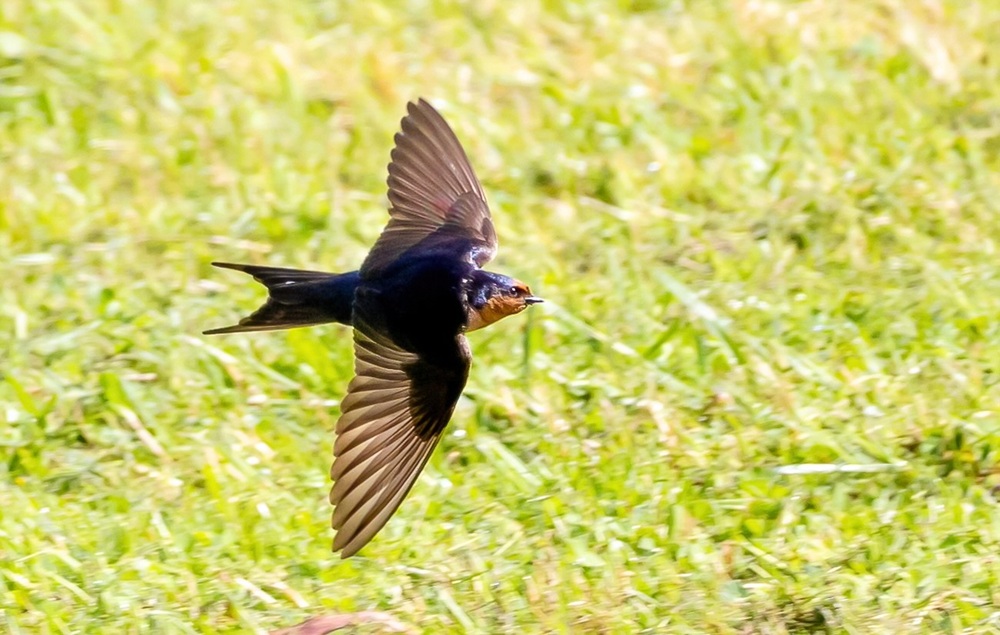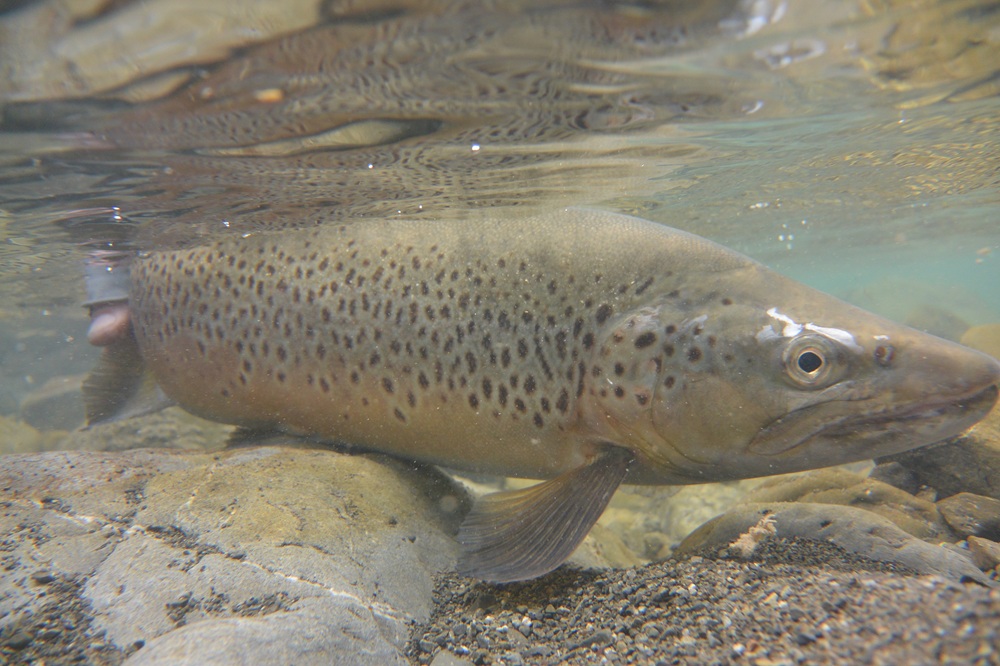
High above Hepburn Lagoon, these anglers have a good view, but are also very visible to the trout. (P. Weigall pic.)
Silhouette on skyline
As mentioned in an earlier instalment of this trilogy, standing high on the casting deck of a tall boat is not conducive to catching fish. Similarly, walking along the top of a dam wall, or levee, or other high bank and casting to fish below, is a poor strategy.
One river I fish has steep banks cut deep into the soil. You will not catch a single trout if you walk along the bank; you must wade in the water with the trout. I’m convinced the fish in this stream become familiar with the local skyline profile above them. Any change to that skyline prompts caution. If something moves against the skyline, it’s game over.
Birds and shadows
During prolific mayfly hatches, it’s common for feeding swallows and, worse still, seagulls to fly over trout and spook them. There’s little we can do to mitigate this; just be aware that the fish has been spooked, and it may be wise to rest that one for a while before attempting to cast to it again.
The flashing shapes and shadows of swallows often spook trout, especially those in shallow water. (Ray Douglas pic.)
We experienced a plague of cormorants here in Tasmania over the past year or two, which had a devastating effect on some parts of our fishery. I suspect the surviving trout adapted to feeding more at night while those predatory birds were roosting. The trout we encounter during the day – at least the ones I could see – were definitely more skittish. Mid-season, a client caught seven trout, and each one had cormorant scars. One particular fish even had five marks! I can only imagine how nervous and skittish these trout must have been after such an onslaught.
Your shadow
Your shadow can be a significant problem, especially early in the morning or later in the day. Sometimes it may stretch 10 to 15 metres. I’ve spooked countless fish on Brumby’s Creek while chasing tailers in the early morning light. Sometimes, conditions compel me to fish from the east bank, and when the sun first rises over the horizon, my shadow can extend to many body lengths, frightening the trout. Try not to move around too much when the sun is low and the fish are close to you.
Wind
Wind clearly influences fish behaviour and, in my opinion, can make them spookier and more difficult to catch.
The east wind is considered ill-fated by many anglers. That old saying states, “When the wind is in the east, it’s good for neither man nor beast.” In my 30 years of guided fishing, I can attest that good fishing during east winds is rare. While there are exceptions, in general, fishing tends to be poorer when the wind is from the east.
My theory relates in particular to the clear, weedy, shallow waters of the Tasmanian Highlands where I guide. Our prevailing winds come from the westerly quarter. The movement of water in our lakes is from west to east, with surface food traveling in the same direction. All the strap-weed and penny weed growing up from the bottom, leans from west to east.
While it’s a tricky concept to grasp, if the lake’s surface is moving from west to east, the current at the bottom flows from east to west. You cannot discern this while wading, but perhaps the fish can sense it.
Brown trout, by nature, are territorial fish. They have relatively small territories, especially when their overall numbers are high. They patrol their environment constantly and familiarise themselves with every detail. An easterly wind disrupts their world, causing everything to lean and move in the opposite direction.
Imagine if I entered your home while you were away and rearranged all your furniture. You would feel confused and unsettled: even if the items of furniture remained the same; they'd be in a different place. Fish survive by knowing their environment intimately, and when they have to relearn it, it must be disorienting for them.
Scent
Many years ago, a skilled fishing mate of mine returned from his regular 10-day trip to the South Island of New Zealand, which he spent at a renowned lodge with an experienced guiding team. I asked him what the most significant lesson was from his trip. After a moment of contemplation, he replied, “Don’t let the fish know you’re there, Peter.” I found this obvious, but he explained what he learned from the guides regarding scent.
On one occasion, the anglers had to walk downstream for a mile before fishing back upstream to their car. They had to cross several small streams feeding into the river. The guides were adamant about not walking in the water of these streams, fearing the disturbance would alert fish in the main river. Initially, this seemed excessive.
This reminded me of an experience from 20 years ago while fishing upstream on Ben Avon Station with a friend. We were cautious, ensuring we remained opposite each other as we moved. When one of us spotted a trout, the other would cross the river to fish to it. This worked well until it was my friend’s turn to fish to a big brown I had spotted on my bank. The shallow riffle above the fish was the obvious place for him to cross.
As I watched the large trout nymphing away, my friend crossed about 80 metres usptream - too far away to be seen. Yet within a minute, the fish stopped feeding and froze, locking itself to the bottom with fins erect. There was no way the fish saw either of us. It could only have smelled my friend wading above.
South Island trout seem especially aware of the smell of anglers, and spook accordingly. (P. Weigall pic)
Flies, poor presentations and casting faults
There’s no doubt that occasionally, your fly can have too much flash. Or, sometimes, how you move your fly can scare fish. While there are no strict rules regarding this, be aware that each day and each fish is different, and you might need to be flexible.
Regularly check your fly to ensure it is behaving properly. Using loop knots is important. A loop knot allows for a more lifelike presentation than a rigid knot. Also, frequently check for weed on your fly, as fish won’t eat flies covered in vegetation.
If you’re going to twitch your dry flies on the surface, remember that a floating leader can disrupt the surface tension, scaring fish away. Moving dry flies can indeed be an effective way to entice fish, but overdoing it, or doing it at the wrong time, can be counterproductive.
False cast water slaps
Under no circumstances should you allow a false cast to slap the water. I can’t believe how often I see anglers make this mistake. I can almost guarantee that in shallow water, if you’ve done this, you won’t catch a fish on your next cast.
You already know my thoughts on crash-landed deliveries. Practice until your fly, leader, and line land gently, like thistledown.
After 30 years, I’m continually amazed at how often anglers cast, only for the fly to land three feet away from their intended target. They immediately pick it up and recast to that target spot, spoiling the water. They would have been better off leaving the fly three feet away from the original target. I frequently see fish approaching the first presentation, only for the angler to lift the line off the water and recast. After such a line slurp, the fish is unlikely to be caught on the second delivery. I often heard the wonderful saltwater guide, Graeme Williams, advise clients to “just live with it” when they made a bad cast. It’s sound advice.
Jiggling of bushes with your snagged fly
If you cast too far and hook a bush on the opposite bank, rather than jiggling the bush back and forth 50 times before breaking off, simply point the rod at the snag and give one slow, smooth, steady pull until the fly breaks free. If there’s a fish nearby, you may still have a chance to catch it if you do this correctly.
Line tear on striking
The noise from a line tear is unavoidable, but if you miss the strike, you must recast to the same spot. Perhaps as many as four out of ten fish will circle back and eat the fly if it’s recast to the exact location. However, the noise of the tearing line often spooks them away.
Don’t attack the fish with the fly
Years ago, I was fortunate to spend a couple of days with the legendary Lefty Kreh. I’ll never forget asking him for advice to pass on to other anglers to help them catch more fish. Lefty thought for a moment before advising me to tell anglers never to attack the fish with their fly. He explained that when pulling wet flies, you should avoid casting across the path of a moving fish and then stripping the fly toward it, as this typically scares the fish. Predatory fish are not used to prey swimming toward them in a jerky, aggressive manner; most prey is trying to escape.
In summary
As I suggested at the beginning of these articles, try to blend into your environment. Make yourself small, move around less, and move much more slowly. Do everything quietly – learn to wade as gently as a heron. Learn to cast like an expert. Your learning curve will accelerate if you can see the fish and observe its behaviour in response to your actions. Remember, when you can’t actually see the fish, similar issues are still occurring, and you may be scaring them without even realising it.













